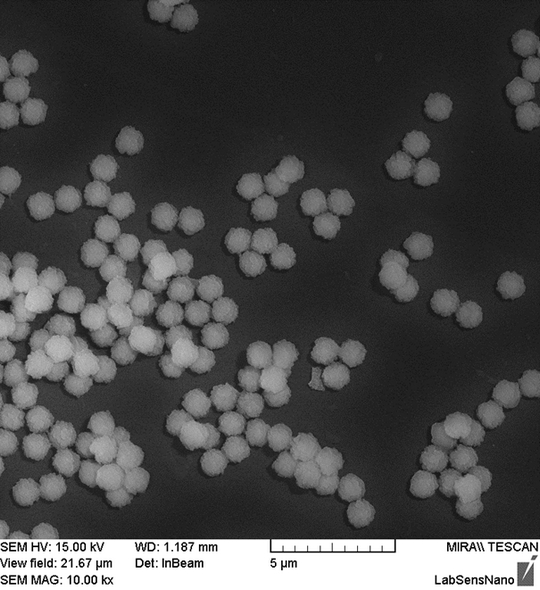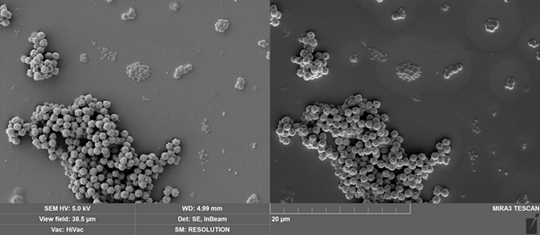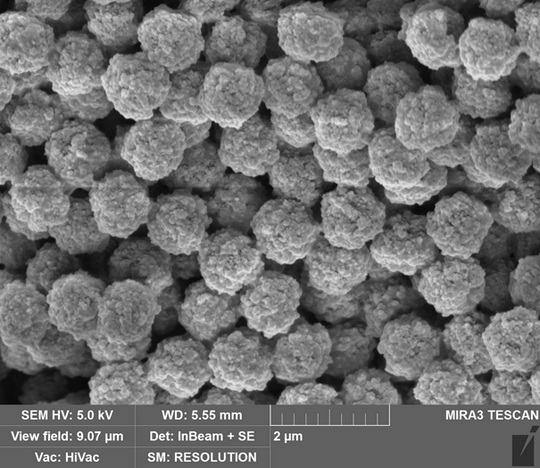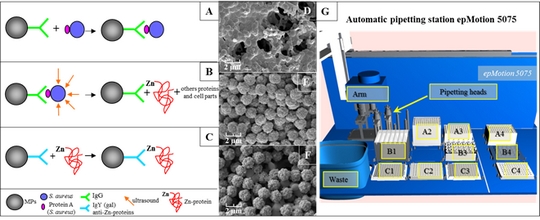

Účelem vzdělání není zaplnit mysl, ale otevřít ji. Čím více poznatků si osvojíme, tím víc si uvědomíme, co ještě neznáme.
Výzkum
An Assay for Isolation of Zinc(II)-Containing Bacterial Proteins Using Microfluidic Coupled with Paramagnetic Particles
 Staphylococcus aureus has become a looming threat due to its increasingly multiple drug resistance to many antibiotics. In 1947, four years after mass production of penicillin began S. aureus penicillin resistant strains were identified [1]. In 1959, methicillin, a new antibiotic, was found to be effective against penicillin-resistant staphylococci. The bacteria eventually became resistant to methicillin which consequently led to the discovery of the first methicillin resistant strain of S. aureus (MRSA) in 1961. Currently, approximately 65% of staphylococcal strains have been identified with MRSA phenotype (resistance to beta-lactam antibiotics and the cephalosporins) [2]. Emergence and the increase number of antibiotic resistance bacteria have resulted in exploring alternatives to antibiotics such as heavy metals complexes [3-7], heavy metal nanomaterials and nanoparticles [8].
Staphylococcus aureus has become a looming threat due to its increasingly multiple drug resistance to many antibiotics. In 1947, four years after mass production of penicillin began S. aureus penicillin resistant strains were identified [1]. In 1959, methicillin, a new antibiotic, was found to be effective against penicillin-resistant staphylococci. The bacteria eventually became resistant to methicillin which consequently led to the discovery of the first methicillin resistant strain of S. aureus (MRSA) in 1961. Currently, approximately 65% of staphylococcal strains have been identified with MRSA phenotype (resistance to beta-lactam antibiotics and the cephalosporins) [2]. Emergence and the increase number of antibiotic resistance bacteria have resulted in exploring alternatives to antibiotics such as heavy metals complexes [3-7], heavy metal nanomaterials and nanoparticles [8].
 Heavy metals, namely zinc based complexes seem to be promising antibacterial agents; however, bacteria pathogens are able to develop or acquire resistance to heavy metals. In 1991, loss of methicillin resistance due to elimination of resistance to heavy metals and tetracycline was reported [9]. Studies found that exposure to nutraceutics, namely zinc derivatives, echinacea and garlic products exhibited resistance to antibiotics in S. aureus [10]. These investigations suggested a strong association between methicillin resistance and zinc [11]. Moodley et al. demonstrated that feed supplemented with tetracycline or zinc increased the number of MRSA in the nasal cavity of pigs [12]. It was discovered that gene czrC encoding zinc and cadmium resistance in MRSA was related to methicillin resistance [13]. This gene is widespread both in humans and animals and is predicted to encode transporters, metal-carrying proteins. Zinc-dependent endopeptidases, , specifically resistance factor HmrA from MRSA, have been found to belong to a group of proteins characterized with zinc and antibiotic resistance [14]. HmrA, an antibiotic resistance factor of methicillin-resistant Staphylococcus aureus, is common among bacterial species. Two zinc-dependent metalloproteases, ZmpA and ZmpB, have been shown to influence the resistance of B. cenocepacia to host antimicrobial peptides [15]. In addition, it was discovered that a fusion protein with a penicillin-binding site and zinc-binding metalloproteinase domain is involved in signal transferring in staphylococcal resistance to beta-lactam antibiotics [16]. Associations between types and levels of heavy metals and specific patterns of antibiotics resistance share cross resistance. Several mechanisms underlie this process and is most important due to their non-specific properties [17]. With the exception of the previous mentioned associations with multiple antibiotic resistance, the following zinc bound proteins possess staphylococcal pathogenic properties: superantigens [18, 19], lysostafin [20] and other extracellular proteases [21], enterotoxins [22], adhesion factors [23], transporter proteins [24], biofilm formation [25], transcription factors, and DNA-binding proteins [26, 27].
Heavy metals, namely zinc based complexes seem to be promising antibacterial agents; however, bacteria pathogens are able to develop or acquire resistance to heavy metals. In 1991, loss of methicillin resistance due to elimination of resistance to heavy metals and tetracycline was reported [9]. Studies found that exposure to nutraceutics, namely zinc derivatives, echinacea and garlic products exhibited resistance to antibiotics in S. aureus [10]. These investigations suggested a strong association between methicillin resistance and zinc [11]. Moodley et al. demonstrated that feed supplemented with tetracycline or zinc increased the number of MRSA in the nasal cavity of pigs [12]. It was discovered that gene czrC encoding zinc and cadmium resistance in MRSA was related to methicillin resistance [13]. This gene is widespread both in humans and animals and is predicted to encode transporters, metal-carrying proteins. Zinc-dependent endopeptidases, , specifically resistance factor HmrA from MRSA, have been found to belong to a group of proteins characterized with zinc and antibiotic resistance [14]. HmrA, an antibiotic resistance factor of methicillin-resistant Staphylococcus aureus, is common among bacterial species. Two zinc-dependent metalloproteases, ZmpA and ZmpB, have been shown to influence the resistance of B. cenocepacia to host antimicrobial peptides [15]. In addition, it was discovered that a fusion protein with a penicillin-binding site and zinc-binding metalloproteinase domain is involved in signal transferring in staphylococcal resistance to beta-lactam antibiotics [16]. Associations between types and levels of heavy metals and specific patterns of antibiotics resistance share cross resistance. Several mechanisms underlie this process and is most important due to their non-specific properties [17]. With the exception of the previous mentioned associations with multiple antibiotic resistance, the following zinc bound proteins possess staphylococcal pathogenic properties: superantigens [18, 19], lysostafin [20] and other extracellular proteases [21], enterotoxins [22], adhesion factors [23], transporter proteins [24], biofilm formation [25], transcription factors, and DNA-binding proteins [26, 27].
 Particle-based proteins extraction is a novel and simple process employing paramagnetic beads coupled with specific antibody, ligand protein or low-molecular mass ligand. There are several protocols for antibody immobilization, proteins, organelles or whole cells. Similar to other immunochemical assays, beads-based protocols maximize optimization and give reliable results [28, 29] as bead-based sensors for pesticides [30], toxins [31], viruses [32] and other pathogens [33, 34], biomarkers [35, 36], detection or separation of rare cells [37-39] or cells sorting and counting [40]. Heavy metal immunoassays utilized anti-heavy-metal antibodies that monitored binding [41] environment pollutants, Pb(II) [42], Hg(II) [43], As(IV, V), Cd(II) [44], Cu(II) [45], U(VI) [46], and rare heavy metals Ru(II) [47] and In(III) [48]. Uranyl-specific antibodies suitable for cellular imaging were developed [49] based on these studies. Antibodies against Zn(II) were successfully prepared in previous investigations [50].
Particle-based proteins extraction is a novel and simple process employing paramagnetic beads coupled with specific antibody, ligand protein or low-molecular mass ligand. There are several protocols for antibody immobilization, proteins, organelles or whole cells. Similar to other immunochemical assays, beads-based protocols maximize optimization and give reliable results [28, 29] as bead-based sensors for pesticides [30], toxins [31], viruses [32] and other pathogens [33, 34], biomarkers [35, 36], detection or separation of rare cells [37-39] or cells sorting and counting [40]. Heavy metal immunoassays utilized anti-heavy-metal antibodies that monitored binding [41] environment pollutants, Pb(II) [42], Hg(II) [43], As(IV, V), Cd(II) [44], Cu(II) [45], U(VI) [46], and rare heavy metals Ru(II) [47] and In(III) [48]. Uranyl-specific antibodies suitable for cellular imaging were developed [49] based on these studies. Antibodies against Zn(II) were successfully prepared in previous investigations [50].
 Magnetic bead-based analytical procedures can be miniaturized, is broadly applicable and widely applied in lab-on-a-chip and robotic sample handling systems [51]. They provide high sensitivity and specificity. The objective of the study was to explore automatic immune-paramagnetic-bead-based methods for cell isolation and techniques for specific protein group separations. Zn(II) binding proteins were extracted from Staphylococcus aureus via specific anti-Zn(II) antibody with minimal handling. The comprehensive isolation scheme is outlined in Fig. 1.
Magnetic bead-based analytical procedures can be miniaturized, is broadly applicable and widely applied in lab-on-a-chip and robotic sample handling systems [51]. They provide high sensitivity and specificity. The objective of the study was to explore automatic immune-paramagnetic-bead-based methods for cell isolation and techniques for specific protein group separations. Zn(II) binding proteins were extracted from Staphylococcus aureus via specific anti-Zn(II) antibody with minimal handling. The comprehensive isolation scheme is outlined in Fig. 1.

Výzkum byl podpořen díky projektu CEITEC CZ.1.05/1.1.00/02.0068
Plakáty k výzkumným směrům
Dokumenty pro VaV aktivity
Výzkumný záměr
Hodnocení výzkumných aktivit
Archív
36— 2014
35— 2014
34— 2014
33— 2014
32— 2014
31— 2014
30— 2014
29— 2014
28— 2014
27— 2014
26— 2014
25— 2014
24— 2014
23— 2014
22— 2014
21— 2014
20— 2014
19— 2014
18— 2014
17— 2014
16— 2014
15— 2014
14— 2014
13— 2014
12— 2014
11— 2014
10— 2014
9— 2014
8— 2014
7— 2014
6— 2014
5— 2014
4— 2014
3— 2014
2— 2014
1— 2014
42— 2013
41— 2013
40— 2013
39— 2013
38— 2013
37— 2013
36— 2013
35— 2013
34— 2013
33— 2013
32— 2013
31— 2013
30— 2013
29— 2013
28— 2013
27— 2013
26— 2013
25— 2013
24— 2013
23— 2013
22— 2013
21— 2013
20— 2013
19— 2013
18— 2013
17— 2013
16— 2013
15— 2013
14— 2013

 | Zemědělská 1/1665 613 00 Brno Budova D | Tel.: +420 545 133 350 Fax.: +420 545 212 044 |  |
 |





